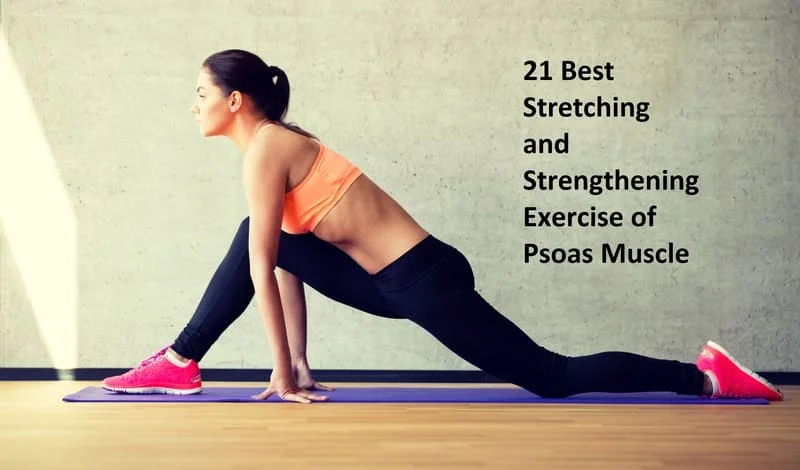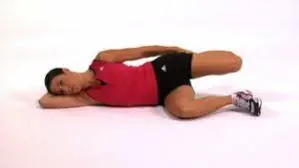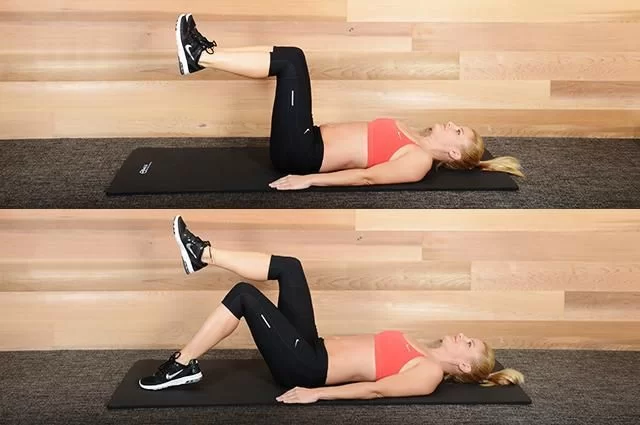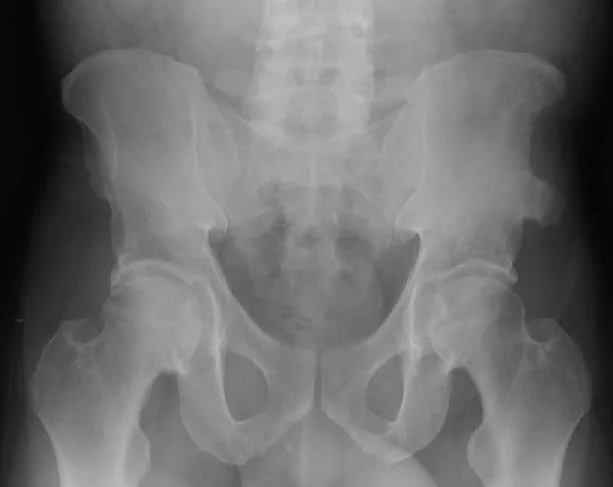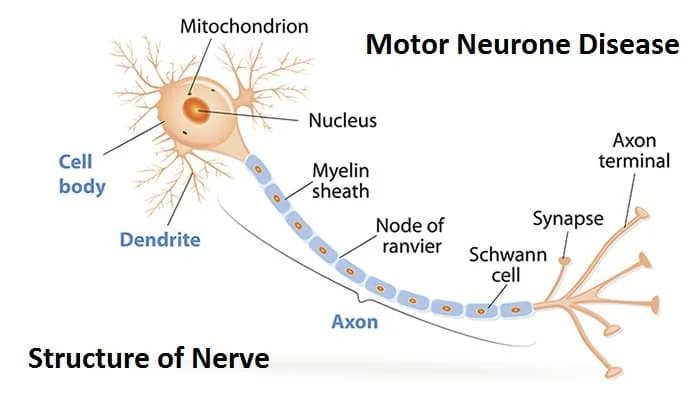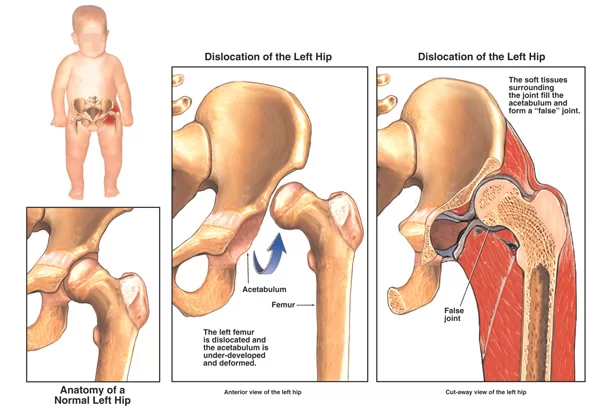21 Best Stretching and Strengthening Exercise of Psoas Muscle
Stretching and strengthening exercises for the Psoas muscle can help alleviate discomfort, improve mobility, and enhance overall lower body function. In this guide, we will explore the best exercises to both stretch and strengthen the psoas muscle for better health and performance.
What is the Psoas Muscle?
The psoas muscle, also known as the iliopsoas, is a deep-seated muscle that runs from the lower spine to the upper thigh bone. It is actually made up of two muscles the one is the psoas major and the other is iliacus. The psoas major originates from the lumbar vertebrae in the lower back, while the iliacus arises from the iliac fossa, which is a curved surface on the inner side of the hip bone.
These two muscles come together to form the iliopsoas tendon, which inserts into the lesser trochanter of the femur (thigh bone). This tendon is responsible for connecting the psoas muscle to the leg bone.
The psoas muscle plays a crucial role in various everyday movements. When it contracts, it flexes the hip joint, which means it brings the thigh closer to the torso. This action is important for activities such as walking, running, climbing stairs, and bending forward. The psoas muscle is also involved in stabilizing the lower back and maintaining proper posture.
In addition to its role in movement, the psoas muscle is also important for supporting the spine. It helps to maintain the natural curvature of the lower spine and provides stability to the lumbar region. This is why a weak or tight psoas muscle can lead to issues such as lower back pain and limited range of motion.
A tight psoas muscle can occur due to prolonged sitting, poor posture, repetitive movements, or muscle imbalances. When the psoas muscle is tight, it can pull on the lower spine, causing discomfort and potentially leading to other issues such as hip pain and reduced mobility.
Psoas Muscle Exercise
There are two types of exercise for psoas muscle
- strengthening exercise for the psoas muscle
- stretching exercise for the psoas muscle
Strengthening exercise for the psoas muscle
Hanging leg raises
Hanging leg raises are an advanced exercise that specifically targets the psoas muscle. This exercise requires a pull-up bar or a set of parallel bars to hang from. These are the steps for performing hanging leg raises:
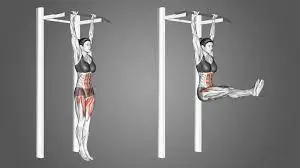
- Begin by hanging from the bar and your arms should be fully extended and your shoulders should be relaxed. Your body should be straight and your legs together.
- Engage your core muscles and stabilize your upper body by pulling your shoulder blades down and back.
- Gradually raise your legs up in the direction of your chest and maintain them straight. Use your core strength to control the movement, avoiding any swinging or momentum.
- Continue lifting your legs until they are parallel to the ground or as high as you can comfortably go.
- Pause momentarily at the top of the movement, then slowly lower your legs back down to the starting position.
- Do it again for the several repetitions.
Hanging leg raises effectively engage the psoas muscle because it requires hip flexion against gravity. This movement helps to strengthen and stretch the psoas, improving its overall function and promoting proper posture and movement.
Bridging Marches
Bridging Marches is an exercise that targets the psoas muscle, which is located deep in the core of the body. This muscle plays a crucial role in stabilizing the pelvis and supporting the lower back, but it can become tight and weak due to prolonged sitting or poor posture. Bridging Marches can help strengthen and stretch the psoas muscle, improving its function and reducing the risk of injury.
To perform Bridging Marches, follow these steps:
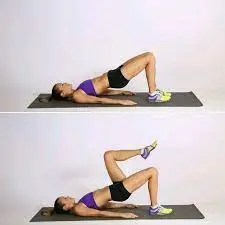
- Begin by lying on your back your knees should be bent and your feet must be flat on the ground. Your arms must be by your sides and palms should be facing downward.
- Engage your core muscles by drawing your belly button in the direction of your spine. This will help in stabilizing your pelvis and protecting your lower back.
- Raise your hips off the floor up to your body and create a straight line from shoulders to knees. Your weight should be evenly distributed across both feet and your shoulders should be relaxed.
- Once you are in the bridge position, lift one foot off the ground and bring your knee towards your chest. Hold this position for a few seconds, then lower your foot back to the ground and repeat on the other side.
- Alternate between lifting each foot for several repetitions, making sure to keep your hips level and stable throughout the movement.
- As you perform Bridging Marches, focus on contracting your glutes and hamstrings to lift your hips, while also engaging your core muscles to maintain stability. This will help activate the psoas muscle and improve its strength and flexibility over time.
- Repeat for several sets of 10-15 repetitions, or as many as you feel comfortable with.
V sits
V-sits are a great exercise for strengthening the psoas muscle, which is located deep in the abdomen and connects the spine to the legs. Here’s how to perform V-sits:
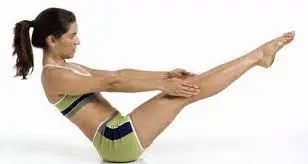
- Sit on the floor with your legs straight out in front of you and your hands resting on the ground beside your hips.
- Engage your core muscles and lift your legs off the ground, bringing them up toward your chest.
- At the same time, reach your arms forward and lift your upper body off the ground, forming a V-shape with your body.
- Hold this position for a few seconds, then slowly lower your legs and upper body back down to the starting position.
- Repeat for several reps, gradually increasing the number of reps and sets as you get stronger.
It is essential to keep your core engaged throughout the exercise to protect your lower back and ensure proper form. You can also modify the exercise by bending your knees or using a support like a yoga block or towel under your hips if you need extra assistance.
Stability Ball Passes
Stability ball passes are another effective exercise for strengthening the psoas muscle. Here’s how to perform this exercise:
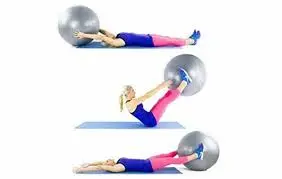
- Lie flat on your back on a mat or the floor with your arms extended above your head and your legs straight out in front of you.
- Hold a stability ball between your feet, squeezing it tightly to keep it in place.
- Engage your core muscles and lift your legs and the stability ball off the ground, bringing them up toward your chest.
- At the same time, reach your arms forward and lift your upper body off the ground, forming a V-shape with your body.
- Pass the stability ball from your feet to your hands, then lower your legs and upper body back down to the starting position.
- Repeat the exercise, passing the stability ball back and forth between your hands and feet for several reps.
It is very crucial to keep your core engaged throughout the exercise to protect your lower back and ensure proper form. You can also modify the exercise by using a smaller stability ball or adjusting the weight of the ball as needed. As you get stronger, you can increase the number of reps and sets to challenge yourself further.
Mountain Climbers With Ankle Weights
Mountain climbers with ankle weights are an effective exercise for strengthening the psoas muscle. Here’s how to perform this exercise:

- Begin in a plank position with your hands shoulder-width apart and your ankles weighted.
- Engage your core muscles and bring your right knee up towards your chest, keeping your left leg extended behind you.
- Quickly switch legs, bringing your left knee up towards your chest and extending your right leg behind you.
- Continue alternating legs in a quick, running motion for several reps.
- Be sure to keep your hips level and your core engaged throughout the exercise to protect your lower back and ensure proper form.
- You can modify the exercise by adjusting the weight of the ankle weights or the speed of the movement.
As you get stronger, you can increase the number of reps and sets to challenge yourself further. This exercise not only targets the psoas muscle but also works the core, glutes, and legs.
Suspension Straps Pikes and Tucks
Suspension straps pikes and tucks are another effective exercise for strengthening the psoas muscle. Here’s how to perform this exercise:
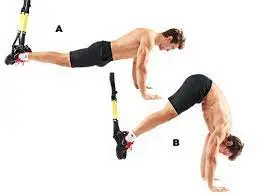
- Begin by attaching suspension straps to a sturdy anchor point, such as a door frame or pull-up bar.
- Stand facing away from the anchor point with your feet hip-width apart and grasp the handles of the suspension straps.
- Engage your core muscles and lift your legs off the ground, coming into a plank position with your body in a straight line from head to heels.
- From this position, bring your hips up towards the ceiling, lifting your legs and bending at the waist to form a pike position.
- Lower your hips back down to the plank position and then bring your knees towards your chest, tucking them in towards your body.
- Lower your legs back down to the plank position and repeat the pike and tuck movements for several reps.
- Be sure to keep your core engaged throughout the exercise to protect your lower back and ensure proper form.
- You can modify the exercise by adjusting the angle of your body or the speed of the movement.
As you get stronger, you can increase the number of reps and sets to challenge yourself further. This exercise not only targets the psoas muscle but also works the core, shoulders, and arms.
Psoas March
Psoas marching is an exercise that specifically targets the psoas muscle, which is located deep in the core and connects the lower spine to the hip joint. Here’s how to perform this exercise:
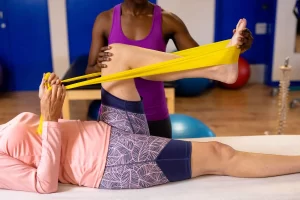
- Begin by lying on your back and your feet should be flat on the ground.
- Lift one foot off the ground and bring your knee towards your chest, keeping the other foot on the ground.
- Loop a mini resistance band surround at the balls of both feet.
- As you bring your knee towards your chest, engage your core muscles and press your lower back into the ground.
- Slowly lower your foot back down to the ground and repeat the movement with the other leg.
- Alternate legs for several reps, keeping your movements slow and controlled.
- You can increase the intensity of the exercise by adding ankle weights or holding a lightweight on your chest.
Psoas marching is a low-impact exercise that can be done anywhere and is suitable for all fitness levels. It helps to strengthen the psoas muscle, which can improve posture, reduce lower back pain, and enhance overall core stability.
Camel pose
Camel pose, also known as Ustrasana, is a yoga pose that can be effective in stretching and strengthening the psoas muscle. Here’s how to perform this exercise:
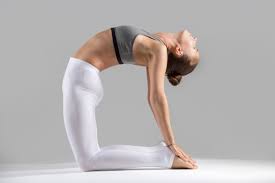
- Initiate by kneeling on a very soft surface, just like a yoga mat or carpet. Put your hands on your lower back, and your fingers should be pointing down in the direction of your hips.
- Slowly begin to arch your back, pushing your hips forward and lifting your chest towards the ceiling.
- You should feel a stretch in the front of your body, particularly in the psoas muscle.
- If you feel comfortable, you can reach back with your hands and place them on your heels, further intensifying the stretch.
- Hold the pose for 20-30 seconds, then release and come back to a neutral position.
- Repeat the exercise several times, gradually increasing the duration of the stretch as you become more comfortable.
Camel pose is a great way to stretch and strengthen the psoas muscle, as well as improve overall flexibility and posture. However, it is necessary to listen to your body and not push yourself too hard. If you feel any pain or discomfort, do not perform the exercise and consult with a healthcare provider.
Glute bridge
The glute bridge is another exercise that can help stretch and strengthen the psoas muscle. Here’s how to perform this exercise:
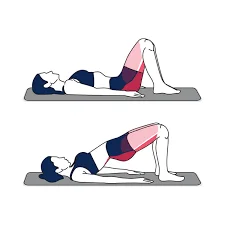
- Lie on your back on a mat or carpet with your knees bent and your feet flat on the ground.
- Put your arms at your sides and your palms should be facing down.
- Engage your glutes and core muscles, and slowly lift your hips up towards the ceiling.
- Keep your shoulders and feet firmly planted on the ground, and hold the position for a few seconds.
- Gradually decrease your hips back down to the floor, and do again this exercise for a few repetitions.
- To intensify the stretch, you can place a yoga block or cushion between your knees and squeeze it as you lift your hips.
The glute bridge is an effective exercise for stretching and strengthening the psoas muscle, as well as improving overall core stability and posture. However, it is very important to maintain proper form and avoid arching your back or straining your neck during the exercise. If you feel any pain or discomfort, do not perform the exercise and consult with a healthcare provider.
Knee to chest
The knee-to-chest exercise is a simple and effective way to stretch and strengthen the psoas muscle. Here’s how to perform this exercise:
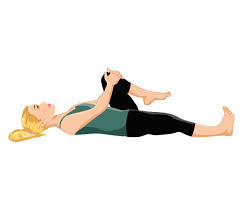
- Lie on your back on a mat or carpet with your legs extended.
- Bring one knee in the direction of your chest, and grasp your knee with both hands.
- Keep your opposite leg extended and resting on the ground.
- Hold the stretch for 15-30 seconds, feeling a gentle stretch in your hip and lower back.
- Let out the stretch and do it again with the other leg.
- To intensify the stretch, you can gently rock back and forth while holding your knee to your chest.
The knee-to-chest exercise is a great way to improve flexibility and mobility in the psoas muscle, as well as alleviate tension and discomfort in the lower back and hips. However, it is very important to avoid straining or pulling too hard during the stretch, as this can cause injury. If you feel any pain or discomfort, do not perform the exercise and consult with a healthcare provider.
Frankensteins
Frankensteins for psoas muscle is an exercise that targets the psoas muscle, which is a deep muscle that runs from the lower back to the top of the thigh bone. The psoas muscle is responsible for flexing the hip joint and stabilizing the spine.
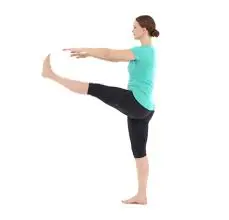
To perform Frankensteins for psoas muscle exercise, follow these steps:
- Stand with your feet hip-width distance and your arms should be by your sides.
- Raise your right leg straight out in front of you, and maintain it as straight as possible. Your toes must be pointed in the direction of the ceiling.
- Keeping your right leg straight, lower it back down to the ground.
- Do it again with the same motion with your left leg.
- Continue alternating legs for 10-12 repetitions.
Frankensteins for psoas muscle exercise can help improve hip flexibility, strengthen the psoas muscle, and reduce lower back pain. It is a low-impact exercise that can be performed anywhere and does not need any equipment.
Romanian Chair Leg Raises with Dumbbell
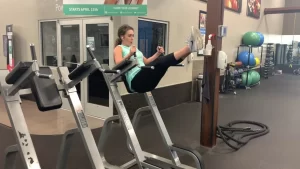
- Sit in the Roman chair and place a small dumbbell firmly between your feet.
- Keep your torso upright and press the lower back against the backrest while your forearm rests on the pad.
- Raise your legs until they come parallel to the floor by flexing at the hips while holding your knees straight.
- Reverse slowly to the starting position and then continue.
This exercise helps in Increasing the strength of all your core muscles while focusing on the psoas.
Low Lunge Twist
The Low Lunge Twist is another exercise that targets the psoas muscle, as well as the hip flexors and the spine. It is a yoga pose that can be performed on a yoga mat or other flat surface.
To perform the Low Lunge Twist for psoas muscle exercise, follow these steps:
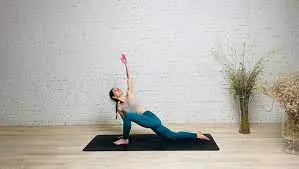
- Begin in a low lunge position with your right foot forward and your left knee on the ground behind you. Your right knee must be directly over your ankle.
- Put both hands on the floor on either side of your right foot.
- Inhale deeply and lengthen your spine, lifting your chest towards the ceiling.
- With exhalation twist your torso to the right side, and put your left elbow on the outside of your right knee.
- Hold the twist for 20-30 seconds, then release and switch sides.
The Low Lunge Twist can help improve hip flexibility, reduce lower back pain, and increase spinal mobility. It is a more challenging exercise than the Thomas Stretch, but it provides a deeper stretch for the psoas muscle.
Pyramid Pose
Pyramid Pose, also known as Parsvottanasana, is a yoga pose that targets the psoas muscle, as well as the hamstrings, calves, and spine. It can be performed on a yoga mat or other flat surface.
To perform Pyramid Pose for psoas muscle exercise, follow these steps:
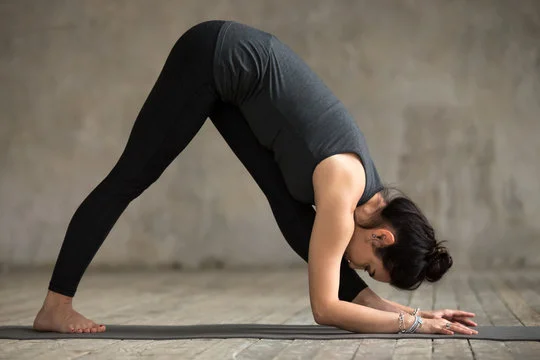
- Start with a standing position and your feet hip-width distance.
- Put your left foot back about 3-4 feet and turn it out at a forty-five-degree angle.
- Maintain your hips facing forward and square your shoulders in the direction of your front foot.
- Inhale deeply and lengthen your spine, lifting your chest towards the ceiling.
- Exhale and fold forward over your front leg, placing your hands on either side of your foot.
- Maintain your back leg straight and push the heel into the floor.
- Maintain the pose for 20-30 seconds, then release and change to other sides.
Pyramid Pose can help improve hip flexibility, reduce lower back pain, and increase spinal mobility. It is a more advanced exercise than the Thomas Stretch and the Low Lunge Twist, but it provides a deeper stretch for the psoas muscle.
Tree Pose
Tree Pose, also known as Vrksasana, is a yoga pose that targets the psoas muscle, as well as the hips, thighs, and ankles. It can be performed on a yoga mat or other flat surface.
To perform Tree Pose for psoas muscle exercise, follow these steps:

- Start with a standing position and your feet hip-width distance.
- Shift your weight onto your left foot and raise your right foot off the floor.
- Put the sole of your right foot on the inside of your left thigh, and your toes pointing in the direction of the floor.
- Press your right foot into your left thigh and your left thigh into your right foot, creating a strong connection between the two.
- Take your hands together in front of your heart such as in a prayer position.
- Inhale deeply and lengthen your spine, lifting your chest towards the ceiling.
- Exhale and engage your core muscles to maintain balance.
- Maintain the pose for 20-30 seconds, then release and change to other sides.
Tree Pose can help improve hip flexibility, reduce lower back pain, and increase spinal mobility. It is a more beginner-friendly exercise than Pyramid Pose, but it still provides a good stretch for the psoas muscle.
Stretching exercise for psoas muscle
Kneeling lunge stretch
The kneeling lunge stretch is another effective exercise for targeting the psoas muscle. Here’s how to perform this exercise:
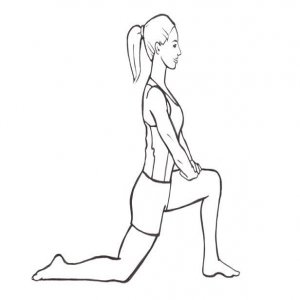
- Initiate by kneeling on a soft surface, just like a yoga mat or carpet. Place a folded towel or blanket under your back knee for added support.
- Step one foot forward and place it flat on the ground, making sure that your knee is directly above your ankle.
- Slowly shift your weight forward, keeping your back straight and your hips square.
- You should feel a stretch in the front of your back leg, particularly in the hip flexor area.
- Maintain the stretch for 20-30 seconds, then release and change sides.
- Repeat the exercise several times on each side, gradually increasing the duration of the stretch as you become more comfortable.
- To intensify the stretch, you can raise your arms overhead or lean back slightly.
The kneeling lunge stretch is a great way to loosen up tight hip flexors and improve flexibility in the psoas muscle. It can also help to alleviate lower back pain and improve overall posture. As with any stretching exercise, it is important to listen to your body and avoid pushing yourself too hard. If you feel any pain or discomfort, do not perform the exercise and consult with a healthcare provider.
Side-lying psoas stretch
The side-lying psoas stretch is a more advanced exercise that targets the psoas muscle, as well as the hip flexors and quadriceps. Here’s how to perform this stretch:
- Lie on your side on a mat or carpet, with your legs extended and your head resting on your arm.
- Bend your top leg and bring your knee towards your chest, keeping your foot close to your buttocks.
- Reach back with your top hand and grasp your ankle or foot.
- Use your hand to gently pull your foot towards your buttocks, feeling a stretch in your hip flexors and quadriceps.
- Slowly lift your bottom leg off the ground and straighten it, keeping it in line with your body.
- Hold the stretch for 15-30 seconds, feeling a deep stretch in your psoas muscle and hip flexors.
- Let out the stretch and do it again on the other side.
The side-lying psoas stretch can be challenging for beginners, so it’s important to start slowly and not push yourself too hard. It is also important to maintain proper alignment and not let your top hip roll forward or backward during the stretch. If you feel any pain or discomfort, do not perform the exercise and consult with a healthcare provider.
Thomas Stretch
The Thomas Stretch is an exercise that targets the psoas muscle, which is a deep muscle that runs from the lower back to the top of the thigh bone. The psoas muscle is responsible for flexing the hip joint and stabilizing the spine.
To perform the Thomas Stretch for psoas muscle exercise, follow these steps:
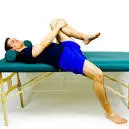
- Lie down on your back on a flat surface, such as a yoga mat or exercise bench.
- Take both knees in the direction of your chest and grasp them with your arms.
- Slowly release one leg and let it hang off the edge of the surface, keeping the other leg hugged to your chest.
- Allow the leg that is hanging to relax and drop towards the ground. You should experience a stretch in your hip and thigh.
- Maintain the stretch for 20-30 seconds, then do it with the other legs and do it again.
The Thomas Stretch can help improve hip flexibility, reduce lower back pain, and prevent injury. It is a gentle and effective way to stretch the psoas muscle, which can become tight and strained from prolonged sitting or physical activity.
Low Lunge
Low Lunge, also known as Anjaneyasana, is a yoga pose that targets the psoas muscle, as well as the hip flexors and quadriceps. It can be performed on a yoga mat or other flat surface.
To perform Low Lunge for psoas muscle exercise, follow these steps:
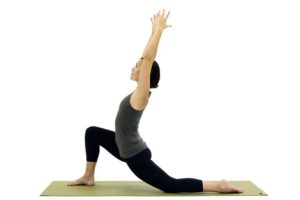
- Start in a tabletop position on your hands and knees, your wrist should be directly beneath your shoulders and your knees should be directly beneath your hips.
- Step your right foot forward between your hands, placing it flat on the ground.
- Do the inhalation and raise your torso upright, take your arms up overhead.
- Engage your core muscles and gently tilt your pelvis forward, feeling a stretch in your right hip flexor and psoas muscle.
- Maintain this posture for 20-30 seconds, then release and change to other sides.
Low Lunge can help improve hip flexibility, reduce lower back pain, and increase spinal mobility. It is a more beginner-friendly exercise than Pigeon Pose, but it still provides a good stretch for the psoas muscle.
Frog stretch
Frog stretch is a yoga pose that targets the psoas muscle, as well as the inner thighs and hips. It can be performed on a yoga mat or other flat surface.
To perform Frog stretch for psoas muscle exercise, follow these steps:
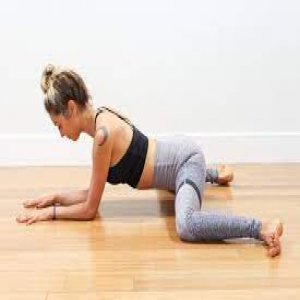
- Start in a tabletop position on your hands and knees, your wrist should be directly beneath your shoulders and your knees should be directly beneath your hips.
- Slowly widen your knees apart until they are slightly wider than hip-width distance.
- Turn your toes outwards, so they are pointing towards the corners of your mat.
- Slowly lower your pelvis towards the ground, keeping your arms straight and your hands flat on the ground.
- Allow your hips to sink down towards the ground, feeling a stretch in your inner thighs and hips.
- Engage your core muscles and gently tilt your pelvis forward, feeling a stretch in your psoas muscle.
- Hold the pose for 20-30 seconds, then release and come back to the tabletop position.
Frog stretch can help improve hip flexibility, reduce lower back pain, and increase spinal mobility. It is a more advanced exercise than Table Stretch, but it provides a deeper stretch for the psoas muscle.
Supta Virasana
Supta Virasana is a yoga pose that can help stretch and strengthen the psoas muscle. These are the step-by-step guide to do this exercise:
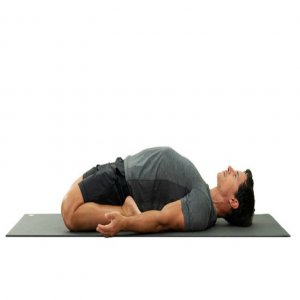
- Begin with kneeling on the ground with your knees hip-width distance and your feet should be pointing straight back behind you.
- Slowly lower your buttocks towards your heels, keeping your thighs perpendicular to the floor.
- As you lower yourself down, lean back onto your forearms and then lie back on your back.
- Your arms can be stretched out to the sides or rest on your stomach.
- If this position is uncomfortable, you can place a bolster or folded blanket under your back for support.
- Maintain this position for 30 seconds to a minute, deep breathing and relaxing into the stretch.
- To release the pose, slowly lift yourself back up onto your forearms and then come back to a kneeling position.
It is essential to listen to your body and not push yourself more than your limit in this pose. If you experience any pain or discomfort, come out of the pose and consult with a healthcare provider.
Benefits of the psoas muscle exercise
The psoas muscle is a deep-seated muscle that connects the lower spine to the upper thigh bone. It is responsible for many movements, such as lifting your leg and bending forward. Here are some of the benefits of exercising the psoas muscle:
- Improved posture: The psoas muscle plays a crucial role in maintaining good posture. A strong and flexible psoas muscle helps align the spine and pelvis, reducing strain on the lower back and improving overall posture.
- Reduced lower back pain: Tightness or weakness in the psoas muscle can cause lower back pain. By strengthening and stretching this muscle, you can alleviate lower back pain and prevent future injuries.
- Better hip mobility: The psoas muscle is one of the primary muscles responsible for hip flexion. By exercising this muscle, you can improve hip mobility, which can enhance athletic performance and reduce the risk of hip injuries.
- Improved breathing: The psoas muscle is connected to the diaphragm, which is the primary muscle responsible for breathing. By exercising the psoas muscle, you can improve diaphragmatic breathing, which can reduce stress and improve overall health.
- Reduced stress: The psoas muscle is often referred to as the “fight or flight” muscle because it contracts when we are stressed or anxious. By exercising this muscle, you can reduce tension and stress in the body.
In summary, exercising the psoas muscle can lead to improved posture, reduced lower back pain, better hip mobility, improved breathing, and reduced stress. Incorporating exercises like Frog stretch into your workout routine can help you achieve these benefits and improve overall health and wellness.
FAQ
What are the characteristics of a tight psoas muscle?
A tight psoas can cause apparently not relevant symptoms involving back aches, leg aches, hip aches, bladder aches, pelvic aches, and digestive issues. It can also come up with Premenstrual syndromes.
What is the reason for weak psoas muscle?
Sitting for a longer time duration. Staying seated for a longer duration can result in weakness in the psoas muscle. This is due to the muscle does not work as hard as if the person were standing.
What is the best treatment protocol for psoas muscle?
Psoas syndrome is best treated with physical therapy. These are often displayed by a doctor or physical therapist in the outpatient office and it can be done at home. These exercises will involve active and passive spine, hip joints, and psoas muscles manipulation and stretching.
Which are the 4 main actions of the psoas?
The actions of psoas major are lateral rotation and flexion of the thigh at the hip. It also helps in the flexion of the trunk at the hip and flexion of the trunk laterally.
Reference
- Sayer, A., & Sayer, A. (2023, September 5). The 6 Best Psoas Muscle Exercises For A Complete Strengthening Guide. Marathon Handbook. https://marathonhandbook.com/psoas-muscle-exercises/
- GoodRx – Error. (n.d.). https://www.goodrx.com/well-being/movement-exercise/psoas-muscle-exercises
- English, N. (2023, August 9). The 5 Best Exercises For a Stronger Psoas. BarBend. https://barbend.com/exercises-stronger-psoas/
- Psoas Constructive Rest – Greenwood Physical Therapy. (2017, November 12). Greenwood Physical Therapy. https://www.greenwoodpt.com/psoas-constructive-rest/#:~:text=If%20there%20is%20tension%20in,also%20contribute%20to%20PMS%20symptoms.
- Image: Marching Bridge. (n.d.). skimble.com. https://www.skimble.com/exercises/27523-marching-bridge-how-to-do-exercise
- Image: Chavan, P. (2014, December 18). Get flatter abs with the V-sit exercise | TheHealthSite.com. TheHealthSite. https://www.thehealthsite.com/fitness/try-the-v-sit-for-flatter-abs-po1214-252600/
- Image: Physiotherapy Exercise. (n.d.). https://www.physitrack.com/exercise-library/how-to-perform-frankenstein-stretch
- Image: Sabic, A. (2023, March 15). How To Do Low Lunge Twist | Benefits, Variations, Modification. YanvaYoga. https://yanvayoga.com/poses/low-lunge-twist/
- Image: Lindberg, S. (2020, November 25). How To Do a Banded Psoas March. Verywell Fit. https://www.verywellfit.com/how-to-do-a-banded-psoas-march-5085782
- Image: Luna, D. (2023, February 9). 4 Effective Hanging Leg Raise Alternatives (With Pictures!). Inspire US. https://www.inspireusafoundation.org/hanging-leg-raise-alternatives/
- Image: Reebok Premium Ankle/Wrist Weights 2 x 1.5kg. (n.d.). Workout for Less. https://www.workoutforless.co.uk/products/reebok-premium-ankle-wrist-weights-2-x-1-5kg

